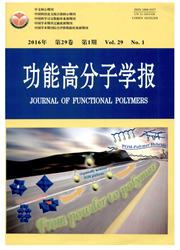

 中文摘要:
中文摘要:
以二硫化二异丙基黄原酸酯(DIP)为链转移剂前驱体,偶氮二异丁腈(AIBN)为引发剂,采用可逆加成断裂链转移(RAFT)溶液聚合合成了低数均分子量(Mn〈1.0×104)和窄分子量分布(Mw/Mn〈1.5)的聚醋酸乙烯酯(PVAc)。用核磁共振(1 H-NMR)、凝胶渗透色谱(GPC)表征了PVAc的结构与分子量。结果表明:溶剂类型、引发剂浓度、链转移剂浓度和聚合反应温度对醋酸乙烯酯RAFT自由基聚合的转化率及可控/“活性”特征有重要影响。在相同条件下,溶剂极性较大的四氢呋喃对PVAc的分子量及其分布的可控性要优于极性较小的苯溶剂;聚合速率及产物分子量分布均随着引发剂浓度的增加而增大;增大DIP的浓度,聚合速率降低,聚合过程的可控性变好;温度升高聚合速率加快,分子量分布指数(PDI)增大。
 英文摘要:
英文摘要:
Polyvinyl acetate (PVAc) with low molecular mass(Mn 〈 1. 0 × 10^4) and narrow molecular mass distribution(Mw/Mn % 1. 5) is synthesized by the reversible addition-fragmentation chain transfer (RAFT) solution polymerization using disulfide, isopropylxanthic disulfide (DIP) as chain transfer agent precursor and azodiisobutyronitrile (AIBN) as initiator. The structure and molecular mass of PVAc are studied by 1H-NMR and GPC. Results demonstrate that the reaction conditions such as type of solvent, content of initiator and chain transfer agent, and polymerization temperature affect the polymerization conversion and controllability. The polymerization controllability in tetrahydrofuran is better than that in ben- zene. The polymerization rate and polydispersity index (PDI) increase with the increasing of the content of the initiator. The lower reaction rate and better controllability of the polymerization are obtained with the increasing of the content of chain transfer agent. The polymerization rate and PDI increase with the increasing of polymerization temperature.
 同期刊论文项目
同期刊论文项目
 同项目期刊论文
同项目期刊论文
 期刊信息
期刊信息
